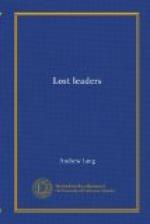This is a deplorable condition of things, and perhaps not quite without example at home, where, however, many people still intend to read books, and order them at the libraries, though they never really carry out intentions which, like those of Wilkins Micawber the younger, are excellent. To persons conscious of mental debility and incapable of grappling even with a short shilling novel, a brief and easy form of reading may be recommended. They may study catalogues; they may peruse the lists of their wares which secondhand booksellers and dealers in all kinds of curiosities circulate gratis. This is the only kind of circular which should not go straight to its long home in the waste-paper basket. A catalogue is full of information. It is so exceedingly inconsecutive that even the most successful barrister, or doctor, or stockbroker (they are the people that read least) need not be fatigued by its contents. The catalogue skips from gay to grave, from Tupper to Aretino, from Dickens to “Drelincourt on Death.” You can pick it up where you like, and lay it down when your poor fagged attention is distracted by a cab in the street, or a bird in the branches. Then there is the pleasure of marking with a pencil the articles which you would buy if you could—the Nankin double bottle, the old novel bound in the arms of the Comtesse de Verrue, the picture ascribed to the school of Potto Pottoboileri. Of course, in these bad times, such purchases are out of the question, but the taste and judgment are gratified by “marking them down,” like partridges in September.
These contemplative reveries on catalogues have been inspired by a catalogue, not without its merits—a list of relics of Mexican history now to be sold. The curious may find it for themselves, the wealthy may speculate in the treasures which it advertises. Here is a piece of the Emperor Maximilian’s waistcoat, “same in which they shot him,” to employ an idiom of Captain Rawdon Crawley’s. There are many relics of the same recent and troublous times; but the amateur is more strongly attracted by a very singular series of objects of the times of the Spanish Conquest, nearly four hundred years ago. It is not so much the obsidian idols, made of that curious bottle-glass-like mineral so fashionable among the Aztecs, as the authentic remains of Fernando Cortes that the collector will covet. What man had ever such fortune as Cortes—he who discovered a new world as strange as a new planet? He conquered a great civilized race, he overthrew a dynasty, not only of mortals, but of gods. Huitzilopochtli and Quetzalcoatl fled from him, and their hideous priests, draped and masked in skins fresh flayed from beasts or men, vanished at his coming, as Isis, Osiris, and the dog Anubis fled from the folding star of Bethlehem. He fought battles like the visions of romance, and he took great and stately cities, with all their temples and towers, which a month before were as unknown to




